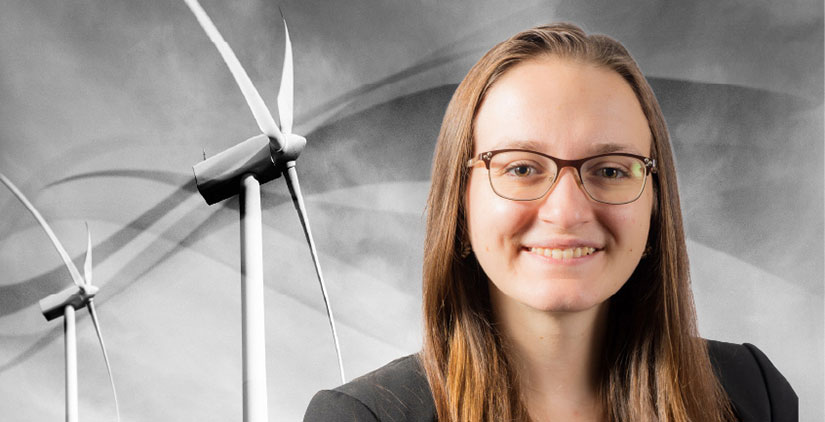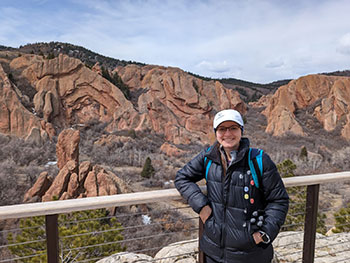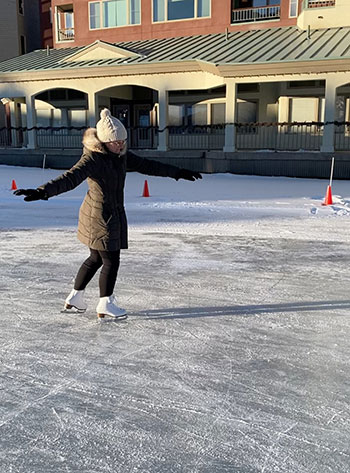Behind the Blades: Why Genevieve Starke Gave Up on Her Childhood Dream Job
A Q&A With a Researcher Who Chose Engineering Over Trickery

As a kid, Genevieve Starke dreamt of becoming a con artist. Inspired by the 1973 hit movie "The Sting," she wanted to orchestrate fraudulent schemes for a living, just like Robert Redford and Paul Newman’s characters.
“That dream died when I found out I’m not super good at breaking rules,” Starke said.
Naturally, the little girl from Pennsylvania decided to pivot her dream to a field where rule-following was a little more appreciated. She picked engineering.
Now a research engineer at the National Renewable Energy Laboratory (NREL), Starke certainly gets to follow a whole lot of rules. But she also gets to write some new ones.
“When you’re doing research, you’re frequently doing things that haven’t been done before,” Starke said. “So there are no instructions or rules to follow—you have to come up with them.”
Starke earned her Ph.D. at Johns Hopkins University, where she researched how groups of wind turbines interact with the wind and each other. She also studied wind farm control systems, which are like the brains of wind turbines. They adjust different parts of wind turbines, like blade angles or the direction a turbine is facing, to change the behavior of the wind farm.
Now, Starke is helping develop the same models she once used during her graduate research. But she has expanded her research beyond just wind energy. She currently works on hybrid energy systems models, which help determine how renewables such as wind, solar, and hydrogen can be integrated into the grid safely, affordably, and reliably.
“It’s been strange to go from someone who runs models to someone who makes models,” Starke said. “Suddenly, you’re the one making all the decisions!”
We caught up with Starke to learn more about her life—within NREL and outside of work. This interview has been edited for clarity and length.

In college, you studied aerospace engineering. How did you eventually end up in wind energy research?
I was doing undergraduate research on supersonic jet flow, studying things like noise from jet exhaust. And because jet flow is supersonic, everything was really fast and produced a lot of data—like a million data points in just 10 seconds. I didn’t like that; it was overwhelming. So for my graduate program, I decided to study the slowest flow I could find. That’s how I got into modeling wind farms.
And what brought you to NREL after you earned your Ph.D.?
A few years into graduate school, I started collaborating with Jennifer King. Her work was really interesting to me, so I was excited to continue working with her after I graduated. I also really liked all the open-source data, models, and tools from NREL. Being able to develop and share those types of resources really appealed to me.
Now that you’ve been here for about two years, what’s your favorite part of working at NREL?
Getting to collaborate with amazing people is probably my favorite part of working here. I especially love getting to work with interns. It’s so exciting to be able to introduce them to what we do and to see what they go on to do after their internships with us!
What advice do you have for an intern or student who might be interested in landing a job like yours?
I think it’s really important to think about what matters most to you and how you work best. If you’re not sure, other people can be some of the best resources. Talk to as many different people as you can to figure out what type of work sounds the most interesting to you.
What do you like to do outside of your work at NREL?
I tend to have a lot of different hobbies, but I only do each of them for a small amount of time. I’m a fan of cycling through things. I play violin, run short distances, ice skate, crochet, sew, draw…

Wow! Do you find that your research style mirrors that desire to cycle through different things?
Yes, I definitely do that in my research life as well! And I think working on hybrid energy systems is a good fit for that. The nature of this work enables me to jump around to different technology areas, which I really enjoy.
Lastly, as we move into the new year, do you have any highlights from your past year at NREL?
One of my favorite parts of the past year was hosting an international meeting! In September 2023, I organized the International Energy Agency Wind Collaboration Programme Topical Expert Meeting #106. The event gathered more than 80 wind, solar, and hydrogen power experts from around the world to talk about how we can grow collaboration between these different renewable technologies.
To learn more about NREL’s wind energy research and the amazing people behind the blades, subscribe to The Leading Edge newsletter.
Last Updated May 28, 2025
